Go back to the summer of 2007 and you’ll find FC Zürich perched atop the Swiss footballing landscape, having just won back-to-back top-flight titles under now-former Borussia Dortmund and, most recently, OGC Nice boss Lucien Favre.
In 2007/08, under Bernard Challandes, Zürich would finish third before the Swiss coach then helped them to return to the top of Switzerland’s Super League in 2008/09.
The team from the famous banking city situated on the Limmat River were a real force to be reckoned with in Switzerland’s domestic game at this time, enjoying a dominant period in the late noughties. That league title under Challandes in 2008/09, however, was the last one FCZ would win for over a decade.
The 2010s were a tumultuous period for the Swiss club, featuring mid-to-lower table finishes and even relegation. By the end of the 2021/22 campaign, though, Zürich returned to their late-noughties heights, winning the Swiss Super League once again under the guidance of André Breitenreiter.
This season has been more of a crash back to reality for FCZ, as they find themselves sitting in eighth place (out of 10 teams) at the time of writing, just four points off bottom-placed Winterthur.
Eighth is the same place they’d finished in 2020/21, making the early 2020s a polarising sandwich for the club, with a historic title victory falling between two lacklustre campaigns.
This team-focused scout report will provide a tactical analysis of the Swiss club’s last couple of seasons, with a particular focus on their struggles in the 2022/23 campaign. Our article will provide an in-depth analysis of some key elements of the tactics used by the different managers Zürich have had in this time and a comparison of these coaches’ respective approaches at Stadion Letzigrund.
Head coach comparison
Title-winning Breitenreiter spent just one season with FCZ, but it was a full campaign in its entirety, at least — he’s the only manager who was present in their successful 2021/22 season. The German coach ended the campaign with an average of 2.11 points per game from the club’s 36 league fixtures last term, seeing his side score 78 goals and concede 46.
Breitenreiter would go on to depart Switzerland for his native Germany, taking the reins at Bundesliga side Hoffenheim for 2022/23. That tenure didn’t replicate the fairytale that his time with Zürich proved to be, as the 49-year-old was relieved of his duties with Hoffenheim in February having guided his side to just 1.14 points per game, leaving them in 14th place in Germany’s top-flight.
The Zürich/Breitenreiter split has transpired in an equally miserable fashion for Zürich. Breitenreiter’s replacement, Franco Foda, ended up taking charge of just eight Swiss Super League games at the beginning of 2022/23, earning a dismal 0.25 points per game in that time. Foda’s Zürich scored just six league goals, conceding 19.
He performed slightly better in Europe, hammering Linfield 5-0 over two legs and overcoming Scottish Premiership side Hearts 3-1 on aggregate to ensure FCZ made it to the UEFA Europa League group stages and received the healthy cash injection that comes along with European football.
However, perhaps speaking from a pessimistic or critical viewpoint, they are teams Zürich should be beating and while they make Foda’s tenure, overall, look a lot better than it was in reality, these victories weren’t enough to save Foda from the sacking that the team’s devastating start to their first title defence in 13 seasons cultivated.
Zürich youth team coach Genesio Collatrella took charge for two games following Foda’s departure before former Midtjylland boss Bo Henriksen arrived in Switzerland.
Under Henriksen, who won a Danish cup with Midtjylland in 2021/22 and guided them to second place in Denmark’s Superliga, FCZ have earned a more respectable 1.53 points per game in 17 fixtures, (the third-best points-per-game ratio of any manager in the Swiss Super League this season) scoring 21 league goals and conceding 20.
In other words, Zürich have conceded just one more goal in 17 league games under Henriksen than they conceded in eight with Foda at the helm — a stark contrast.
Defensive analysis
So, let’s take a look at Zürich’s defence this season, both under Foda and Henriksen, to see what the main issues have been and what Henriksen has done to address them since his arrival.
Firstly, FCZ mainly lined up in a 3-4-3/3-4-1-2 shape under Breitenreiter last season and have generally lined up with the same broad shape this season. However, there was plenty of experimentation during Foda’s short tenure as they scrambled for a winning formula, with different variations of four-at-the-back shapes making several appearances.
This experimentation was ultimately unsuccessful, with Foda’s Zürich drawing two and losing six of their eight games in all competitions lining up with four at the back.
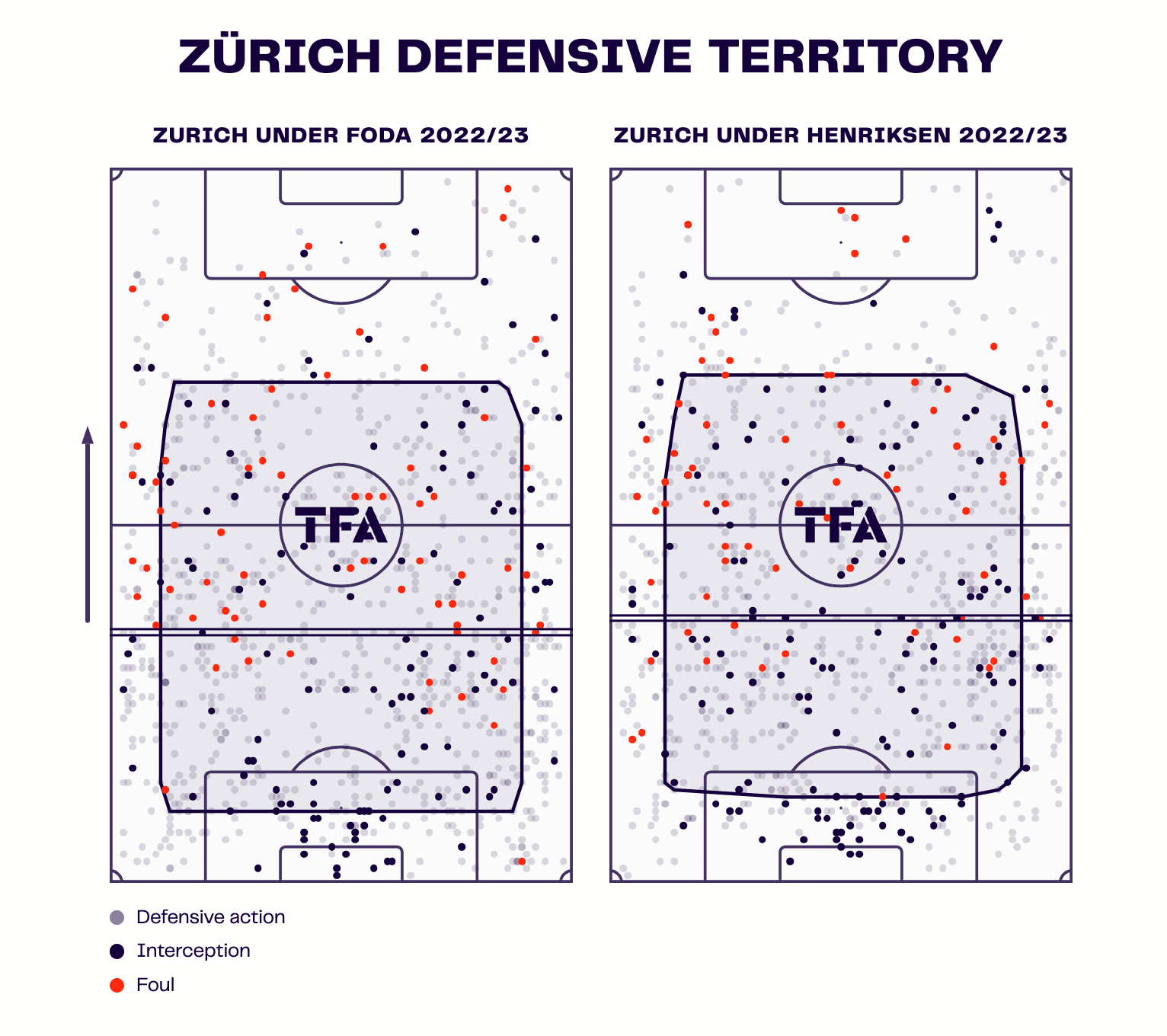
Zürich’s average defensive line height and defensive territory in 2022/23 hasn’t changed much from Foda’s tenure to Henriksen’s tenure, though Henriksen’s FCZ have defended with an ever so slightly higher defensive line.
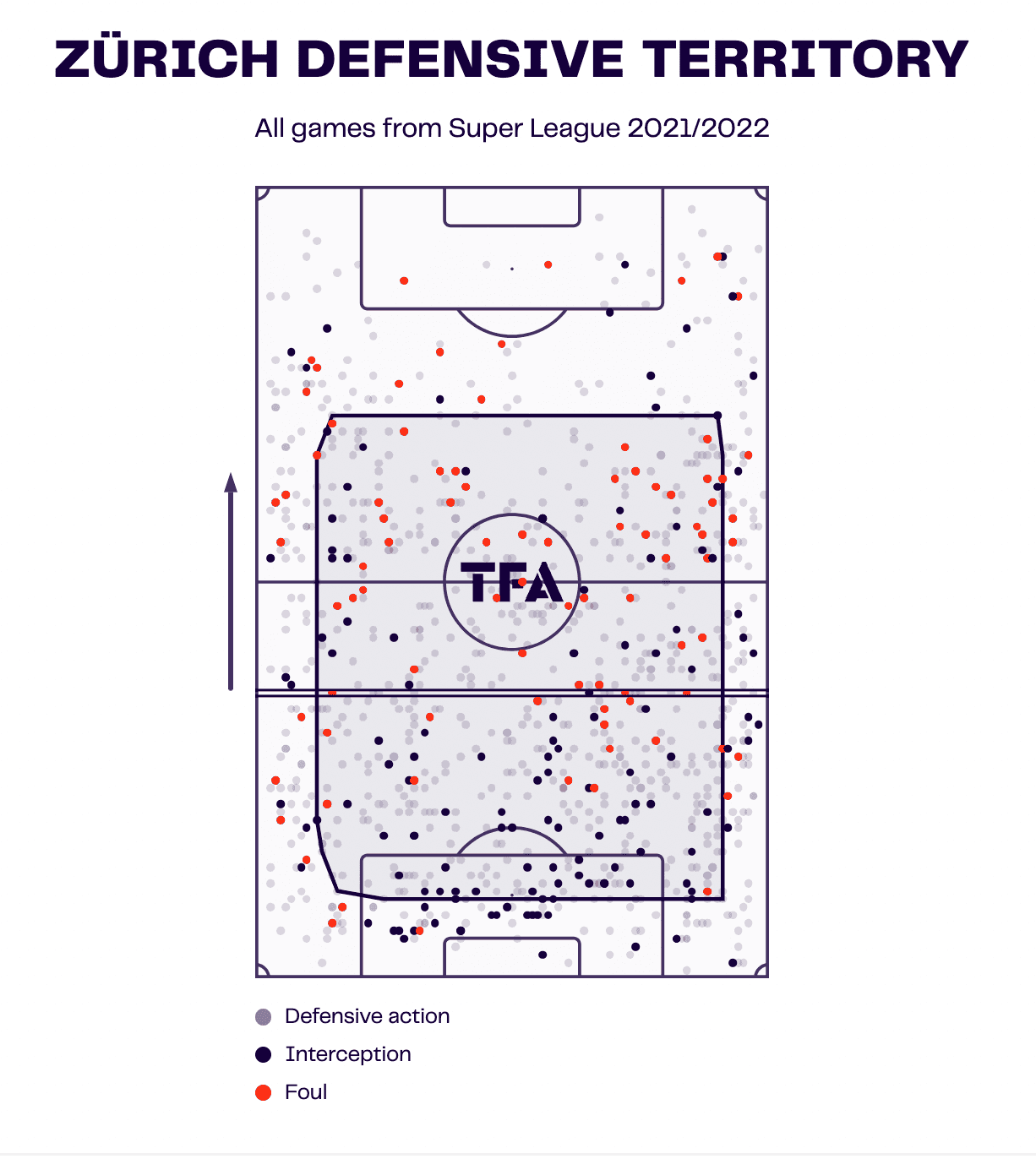
This defensive territory map is pretty consistent with what we saw from the Swiss club under Breitenreiter last season too, though the defensive line, again, is a bit more similar to what we’ve seen under Henriksen this term than what we saw under Foda.
The small adjustment in average defensive line height has been a notable change to FCZ’s game during Henriksen’s time at the club.
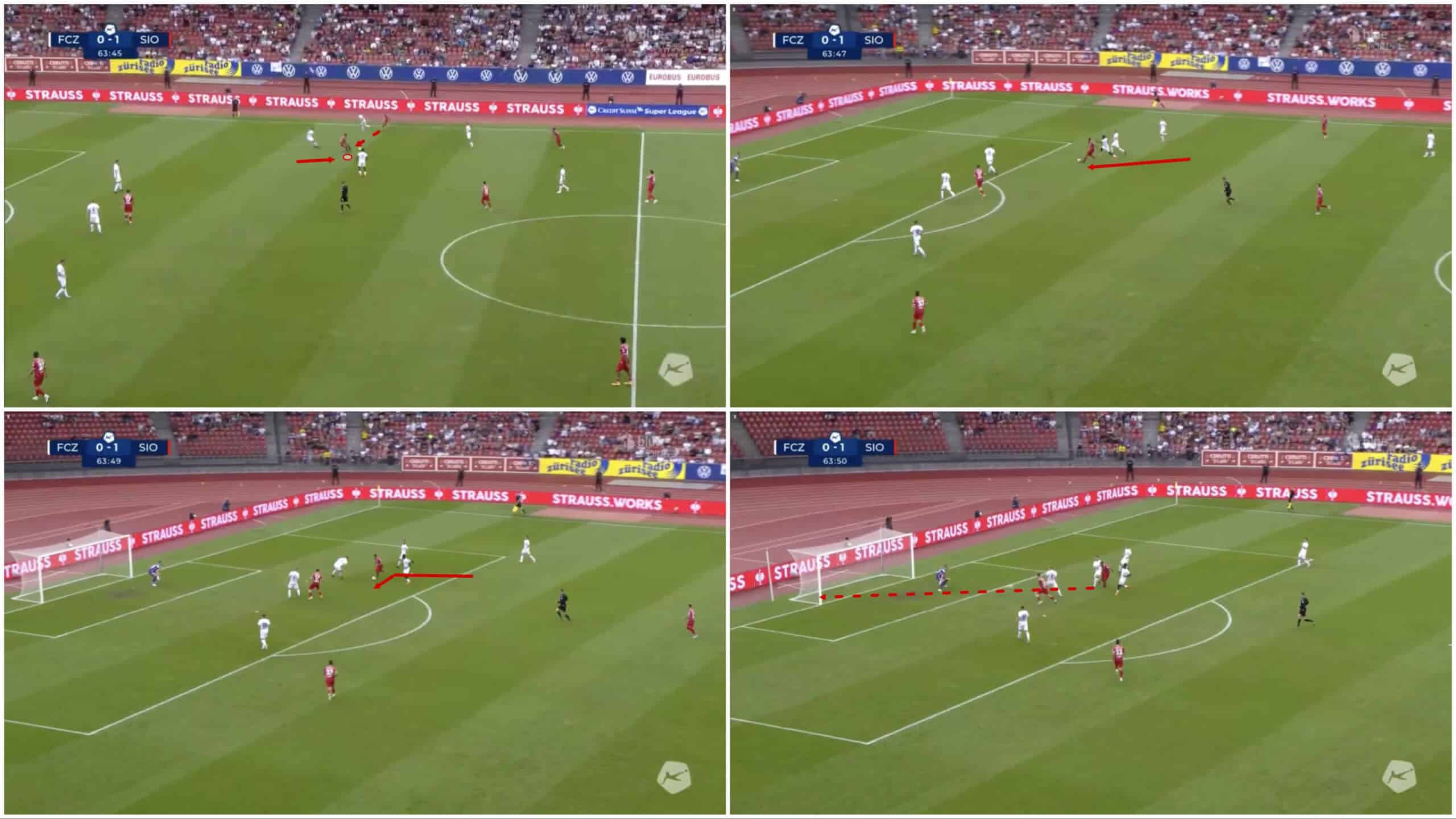
Earlier in the campaign, one of the major issues that led to Zürich conceding so many goals was the amount of space evident between their midfield line and defensive line. To an extent, you can point to the integration of new first-team squad members and the necessary adjustment period the team needed to acclimatise to one another after being assembled.
The likes of midfielders Cheick Condé and Ole Selnæs, along with centre-back Nikola Katić have all been major squad members this season who were new arrivals for 2022/23, for instance.
However, ultimately, regardless of any excuses, there was way too much of a gap between the midfield and backline far too often for opposition attackers to get on the ball and exploit, as Cleilton Itaitinga shows when facing off against FCZ for FC Sion in the early part of the 2022/23 campaign.
Similarly, this example highlights the general lack of intensity that pervaded Foda’s time at the club; in addition to the space between the lines, players acted far too standoffish and basically allowed attackers to casually prance through their defensive shape, as the Brazilian attacker demonstrates here.
The defensive intensity is something that Henriksen has ostensibly attempted to change during his time at the club; in Foda’s eight league games, Zürich averaged a PPDA of 9.67 while that’s dropped to 8.4 in their last eight league games, all of which have occurred under Henriksen.
Additionally, Zürich made 42.37 interceptions per 90 under Foda, while Henriksen’s tenure has seen an average of 49.18 interceptions per 90 (47.87 in the last eight games).
Furthermore, sliding tackles have been a much bigger feature of Zürich’s games under Henriksen (5.18 per 90 overall / 5.87 in the last eight games) than they were under Foda (3.75). This isn’t saying more sliding tackles = good, rather just indicating in collaboration with the other statistics we’ve mentioned that Zürich’s defensive approach has been more aggressive under Henriksen.
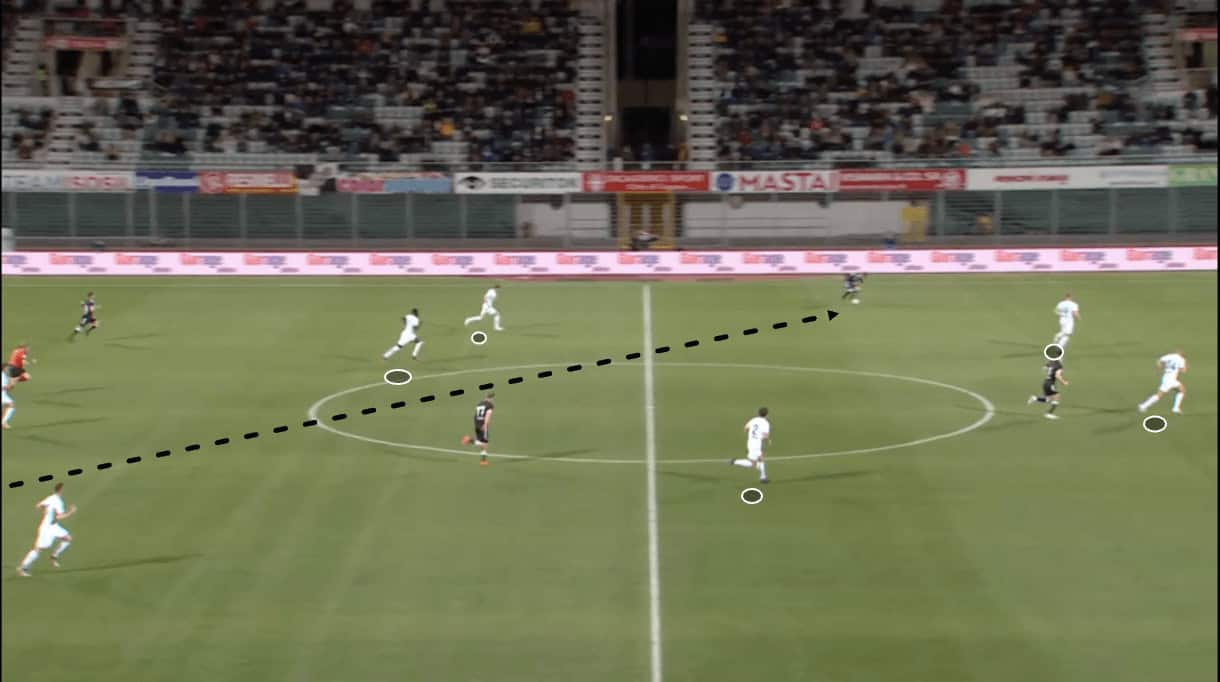
Massive gaps still exist between the lines for attackers to exploit at times and there’s still plenty of work for Henriksen, his coaching staff and the squad to carry out in that regard. Nevertheless, the more aggressive defensive approach has given opposition attackers less time on the ball and fewer opportunities to waltz through the FCZ defence relatively unopposed.
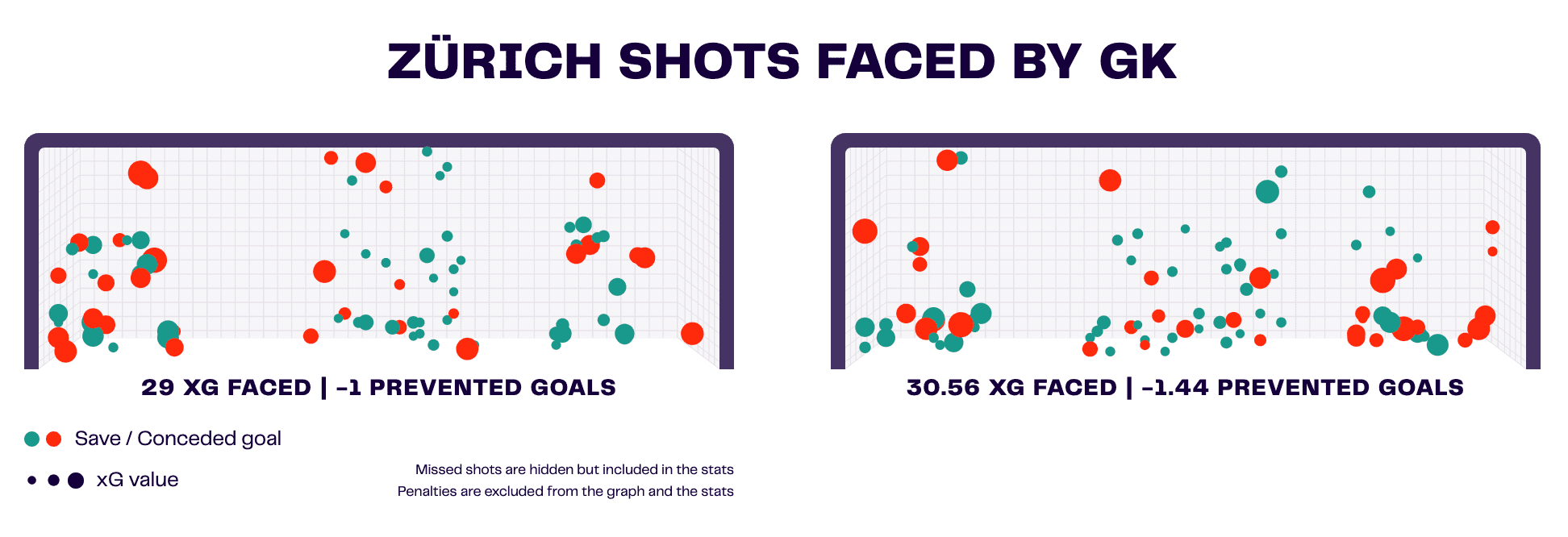
This has seen Zürich concede a similar amount of xG (30.56) in far more games under Henriksen than they conceded in fewer games during Foda’s tenure (29).
Looking at figure 5, it’s also noteworthy that Zürich are in negative prevented goals under both managers. This essentially tells us they’ve conceded more than expected, underperforming in shot prevention — a relevant statistic when looking at the goalkeeper’s performance — though, of course, a natural variance must be taken into account.
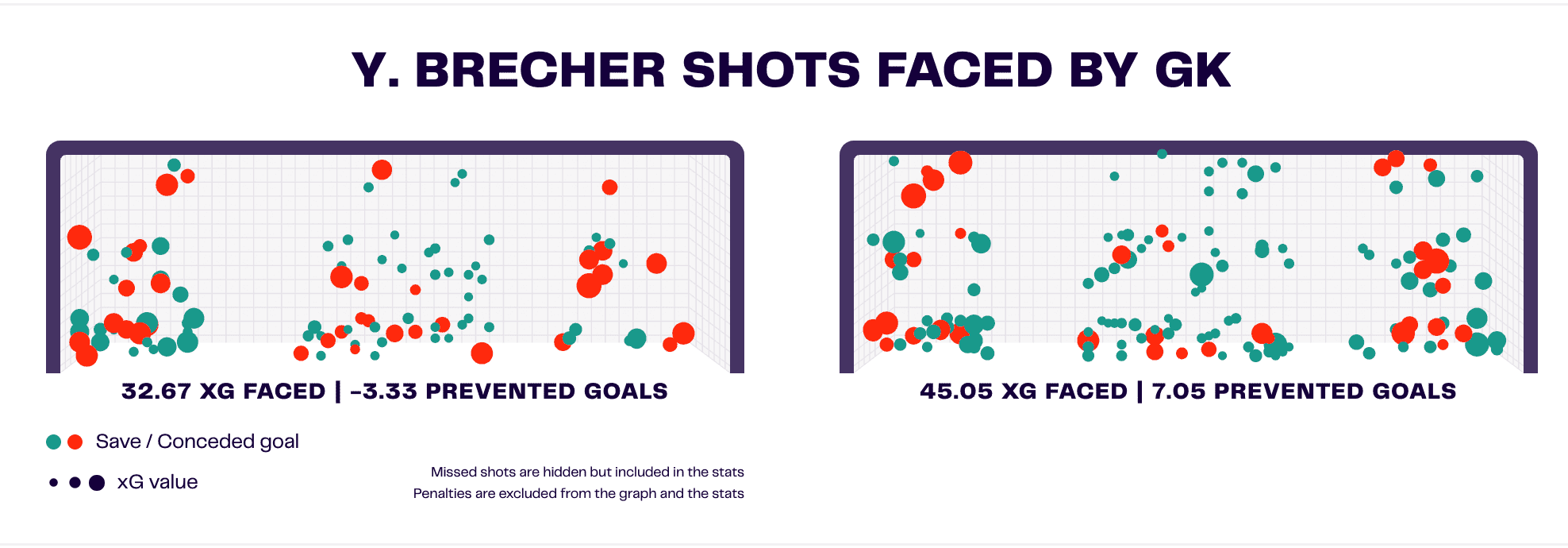
Yanick Brecher has been Zürich’s ‘number one’ for the past two seasons and figure 6 shows his performance over the two campaigns (2022/23 on the left and 2021/22 on the right).
In Zürich’s title-winning campaign, the 28-year-old Swiss stopper played outstandingly well, preventing over seven goals that would’ve been expected to go past him into Zürich’s net.
This season, things are levelling out a bit with the ‘keeper conceding more than he’d have been expected to. This can partly be put down to form, tinkering with systems and personnel in the backline, as well as sheer luck.
But it’s impossible to analyse Zürich’s fall from last season to this season without acknowledging the stark contrast in Brecher’s performances over the two campaigns — to Breitenreiter’s benefit but Foda’s and Henriksen’s detriment.
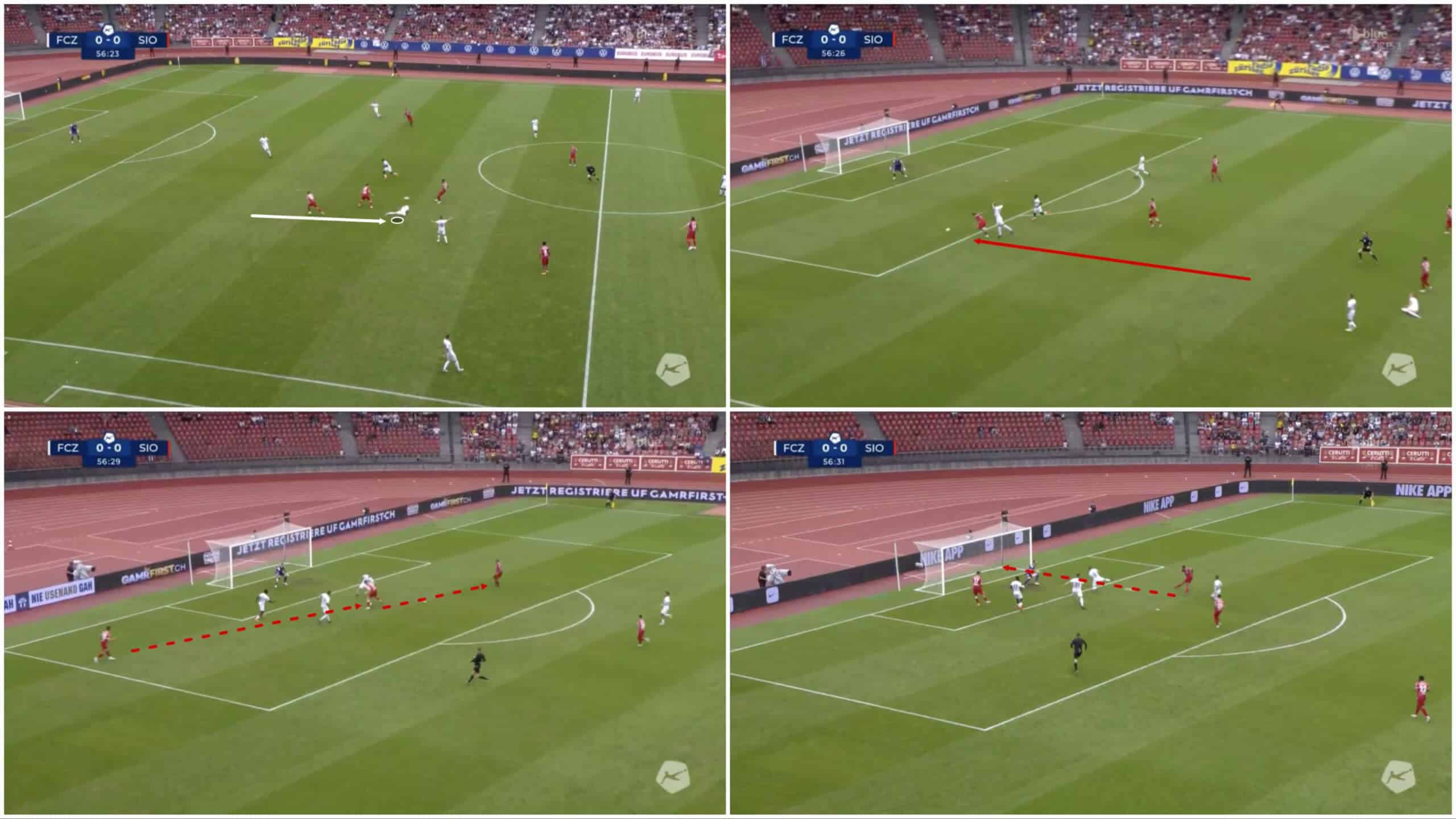
Zürich’s approach on the ball has also had a negative impact defensively, at times, in several ways. Firstly, they’ve been their own worst enemy on a lot of occasions, losing the ball in the build-up or ball progression phases either by taking too much out of it when attempting to carry it out from the back as we see in figure 7 or by misplacing passes.
This has allowed the opponent to counterattack from very advantageous positions and capitalise on the poor possession play.
This was a bigger issue earlier in the season when Foda was trying to get Zürich playing out from the back a little more carefully. During Foda’s tenure, Zürich played an average of 3.47 passes per possession, with that falling to 2.98 in Henriksen’s time as boss.
Henriksen has been happier to see his team playing in a more direct manner — and based on what we’ve seen this term, it’d be fair to say this suits Zürich’s squad better, so it makes sense and helps avoid the unfortunate issues that have occurred when playing out from the back a bit naively without the required personnel to make it work this term.
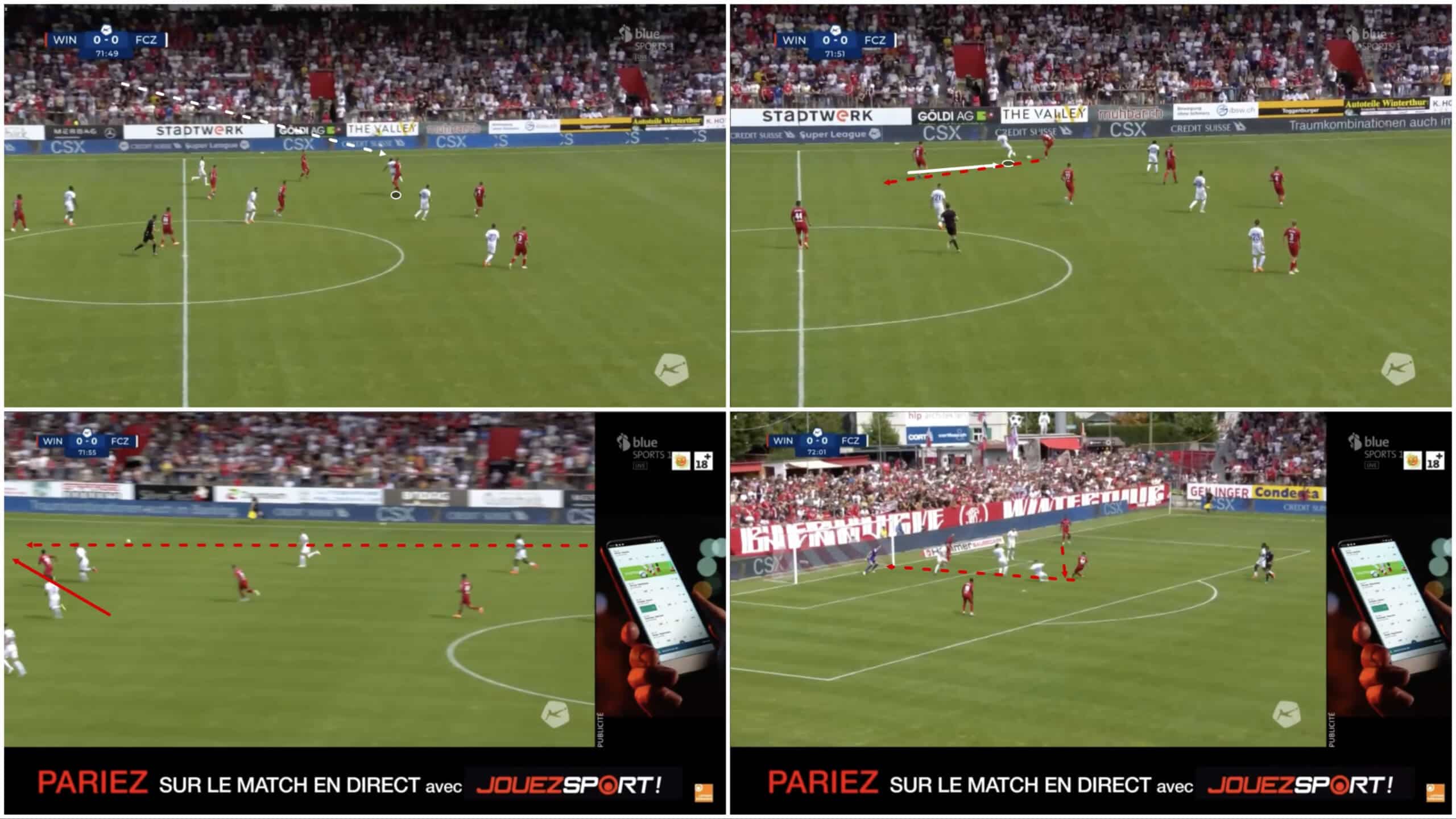
Even when playing long, Zürich have had issues this term. However, again, those issues were more apparent during Foda’s tenure and tied in once more with the overall lack of intensity and aggression shown by the team in the early stages of the 2022/23 campaign.
In figure 8, we see an example of Zürich going long during Foda’s tenure but failing to apply much pressure at all on the second ball. They press half-heartedly, leaving their defensive structure in a sort of limbo that the Winterthur counterattack could only have dreamt of. This allows the opposition to quickly slice through Zürich’s shape, get in behind and score from the counter.
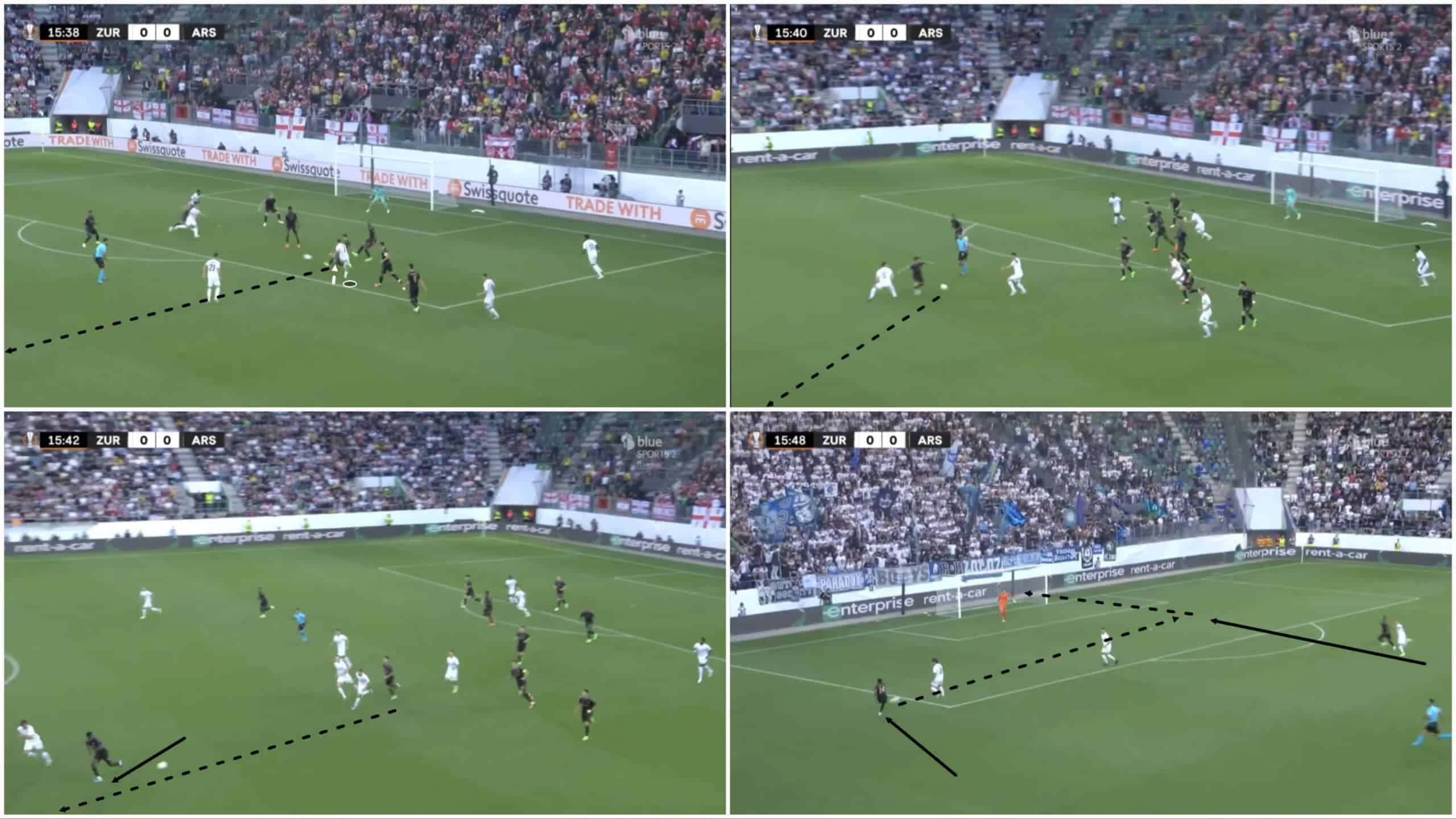
Defensive transitions have been and remain a major problem for this team in 2022/23. FCZ’s rest defence has needed work; there have been problems with too many men committing themselves forward and not enough staying back to provide defensive cover.
Again, the consistent issue of commitment and aggression in the defensive approach has given the opposition a free run through their defence at times, as EPL leaders Arsenal enjoyed in their Europa League clash in Zürich, shown in figure 9.
Again, it must be said, Henriksen has done well to improve the aggression and compactness but it’s still not perfect. It’s undoubtedly a major area of improvement within this Zürich side if they’re to return to the heights they enjoyed last season when compactness and defensive commitment weren’t as much of an issue.
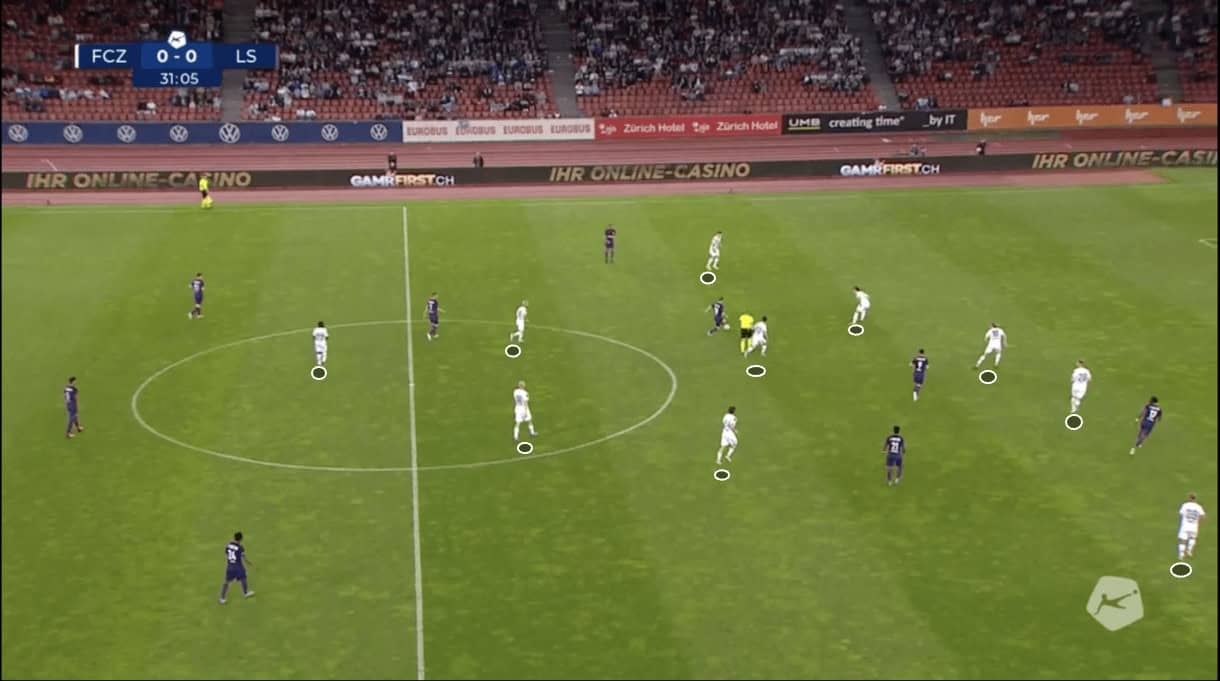
Figure 10 shows an example of Zürich’s defence last season, and we see how the backline and midfield line are positioned far more closely together than they were in any of the examples we’ve seen from 2022/23.
Breitenreiter’s side enjoyed excellent goalkeeping performances from Brecher but they also helped their ‘keeper out more with a more solid defensive structure in front of him; Zürich must strive to get back to this level of defensive organisation and solidity in order to climb back up the Super League table.
Attacking changes
Similar to the natural variance in the shot-stopping performance at the back, there’s been a natural variance in attacking performance at the other end too.
Again, we wouldn’t say a large number of strategic changes have taken place in the short time between the end of 2021/22 and the start of 2022/23 or even the current stage of 2022/23 that are to blame for Zürich’s downfall, as they attack in quite a similar manner on a broad scale from a tactical/strategic perspective.
Zürich make a similar amount of crosses, take a similar amount of shots and play with a similar relatively non-possession-based style this season, especially since Henriksen took charge, as they did last season with Breitenreiter.
Indeed, Foda tried to alter some elements of the playing style to fit his preferred vision of football but it was nothing so dramatic that you wouldn’t even think you’re looking at the same team that Breitenreiter led to glory.
The major issues in the attack have been related to personnel. Zürich were not entirely gutted in the summer transfer market but they lost top scorer Assan Ceesay on a free to Serie A side Lecce as well as fellow attacker Wilfried Gnonto who joined Leeds United for €4.5m late on in the summer transfer window.
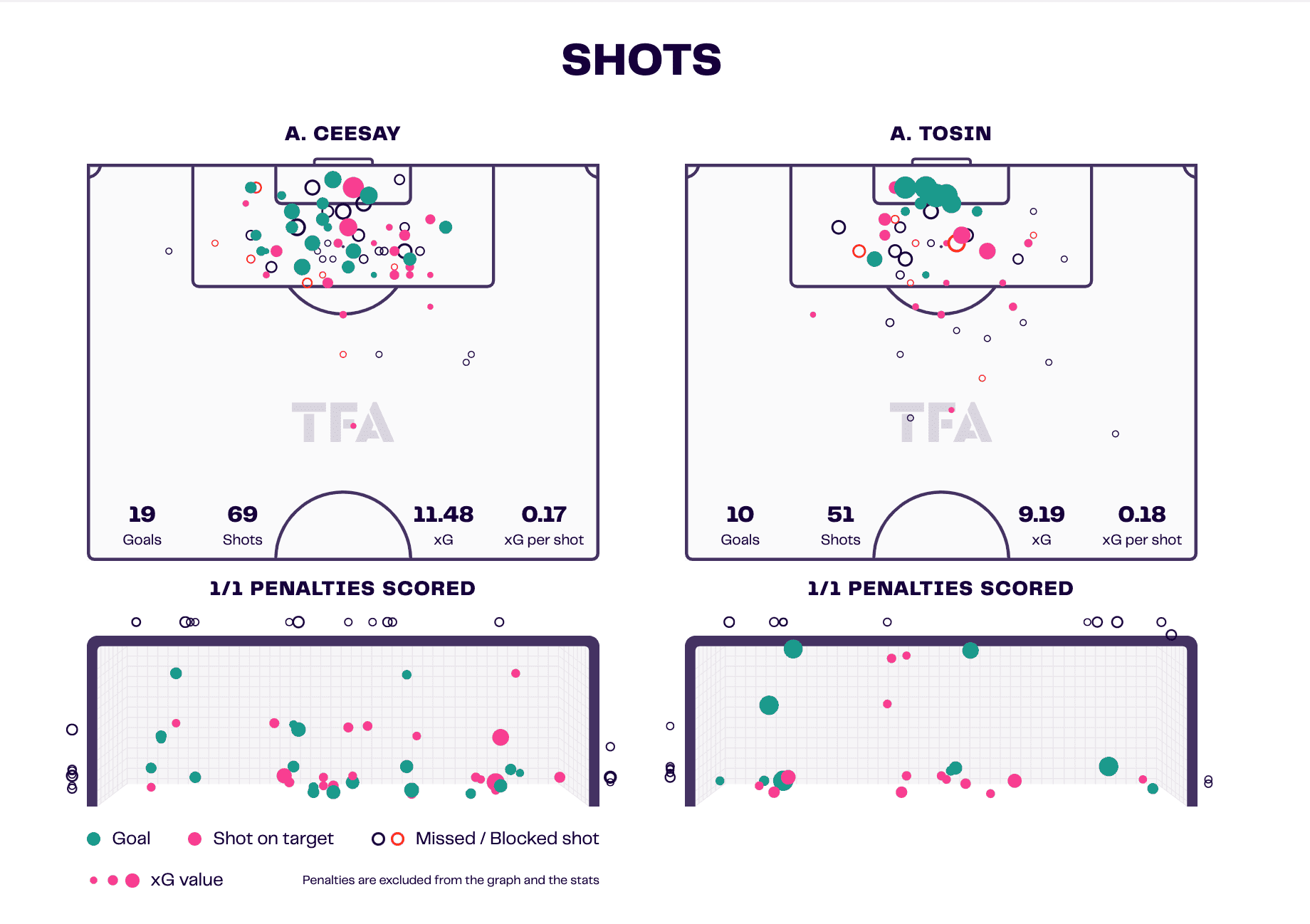
Those two players, combined, contributed 32 goals and 15 assists for Zürich last season, with Ceesay, Breitenreiter’s main frontman, significantly outperforming his 11.48 non-penalty xG, bagging 19 non-penalty goals.
In contrast, as figure 11 displays, Aiyegun Tosin, Zürich’s main centre-forward this season who took over from Ceesay, has scored 10 non-penalty goals from 9.19 xG. Both players had a similarly impressive xG per shot stat with Tosin even outperforming Ceesay there, so it’s not really a case of Tosin generating fewer chances than Ceesay, rather just not overperforming to the unrealistic extent that Ceesay did in 2021/22.
Again, form and luck are important factors to bear in mind here, as is the fact Zürich have been integrating new players into the starting eleven such as the immensely talented but raw Roko Šimić, the injury-disrupted Ivan Santini and Jonathan Okita — who’s been playing utility man all across the frontline this term to cover for injuries and suspensions while settling into the squad (and country) in his own right.
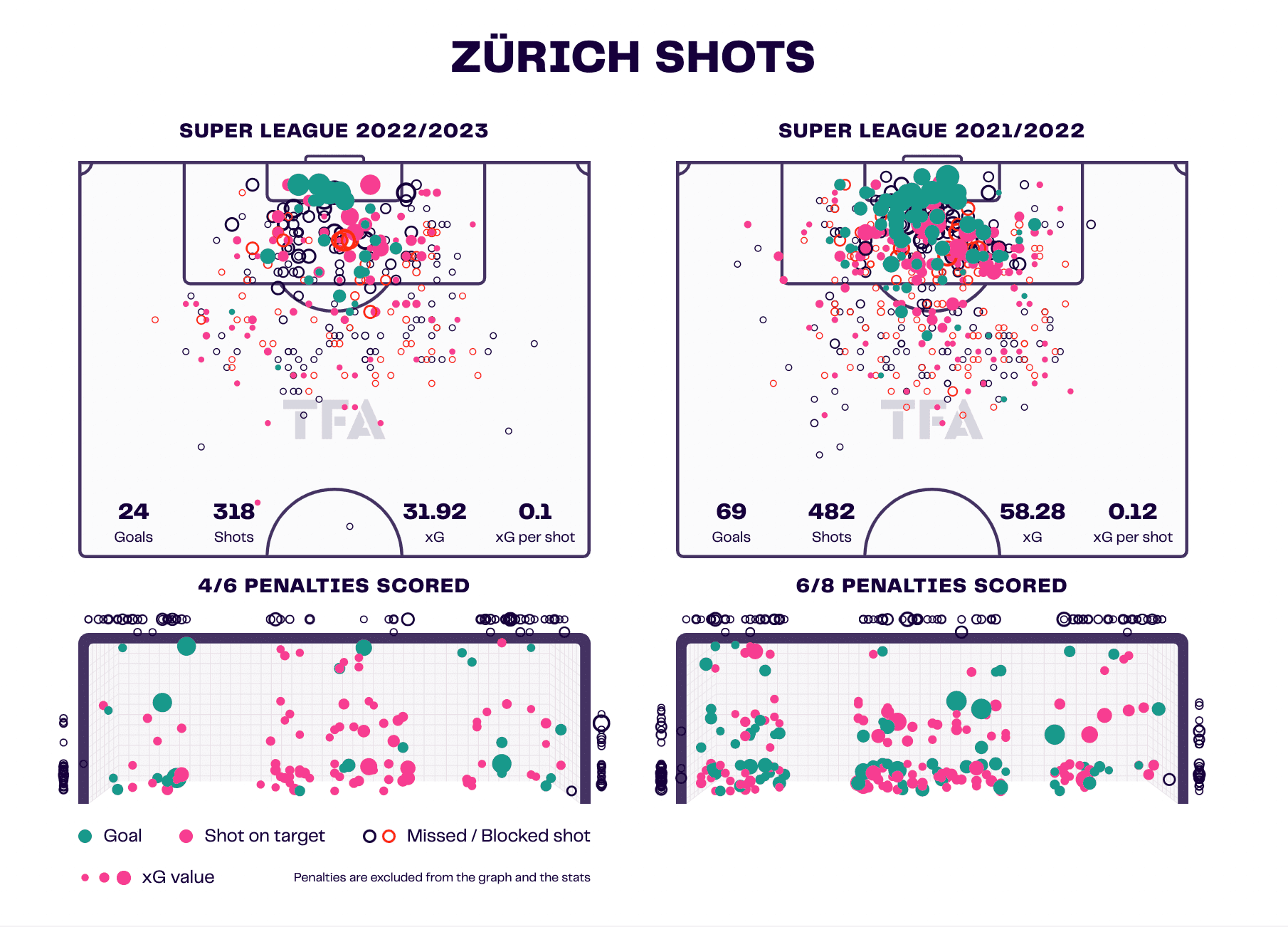
Figure 12 shows Zürich’s overall shot map from this season compared with the same from last season, and it essentially tells the story of a team that’s significantly underperformed this term — scoring almost eight goals less than they’d have been expected to in the 2022/23 Super League — while they significantly overperformed last term, scoring almost 11 goals more than expected.
FCZ have played 27 of their 36 Swiss Super League games so far this season. With an average of 11.16 shots per game this term and 0.1 xG per shot, (the sums they boast at this stage of the campaign) they’d be expected to finish the league season with an xG of 40.176. This would undoubtedly be a significant decrease from last season.
So yes, there have been some issues in terms of not generating as many chances this term as they generated in 2021/22, especially in the early stages of the campaign. However, the personnel issues and evolving squad needing time to mould and get used to one another has played a notable part in this that can’t be ignored.
Conclusion
All in all, while FCZ endured a nightmare start to the season under Foda, we’d say Henriksen has done a decent job at turning the ship around to an extent. No, they’re still not performing at the same levels as last season but as our analysis has shown, some key intangibles fell on their side in 2021/22 to an extent that would be difficult to replicate this term, especially with an evolving squad.
Considering the vastly improved points-per-game ratio Zürich have enjoyed under Henriksen compared to Foda, as well as the Danish coach’s attention to key strategical issues the club had endured under his predecessor, the future is looking okay for FCZ and they need not worry too much about rethinking their plans again just yet. Stability could be key for their rebuild at this point.





Comments